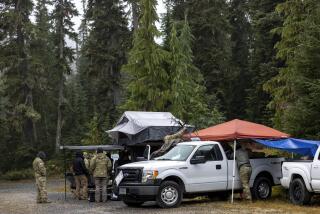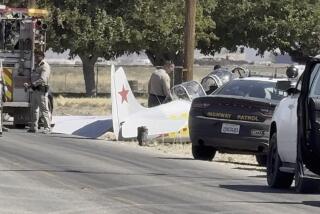Navy Blames Pilot Error in Air Crash : Investigation: Radar tapes indicate one of the P-3 Orions flew upward into the other, causing the collision that killed 27.
The mid-air collision between two P-3 Orion planes that killed 27 crewmen was probably caused by pilot error, Navy sources say.
Although the investigation is still under way, tapes of radar signals indicate that one plane flying at about 2,500 feet climbed into the other plane, flying at about 3,500 feet, which was coming to relieve it during an anti-submarine training mission March 21, 60 miles southwest of San Diego.
“For some reason, the pilot lost awareness of what was going on around him,” said a Navy official familiar with the investigation who requested anonymity.
The Navy is still interviewing witnesses in a Navy helicopter that was 6 miles away and aboard the San Diego-based destroyer Merrill 9 miles away, who saw a fireball as the two turboprop planes hit.
More Navy personnel were killed in the crash, the worst since World War II, than in all of Operation Desert Storm.
“The mishap investigation is not completed,” said Senior Chief Petty Officer Bob Howard, a Navy spokesman. “Nothing has been ruled out.”
The two aircraft were assigned to Patrol Squadron 50, based at Moffett Naval Air Station in Mountain View, Calif. One plane carried a crew of 13; the other carried 14. Both planes had been flying at assigned altitudes.
In Navy vernacular, the crash is tentatively being labeled as “loss of situational awareness.” Officials still don’t know what communication occurred between the two pilots before the crash. But they do believe that the two men were in contact minutes before the planes collided.
Search teams were unable to find a tape of the radio communication in the debris. But, even if the tape were found, it probably would not yield clues to the crash because--unlike a protected black box in a commercial aircraft--the recorder in a P-3 is not waterproof, fire-resistant or designed to endure a crash.
Senior Navy officers are now considering whether to once again comb the sea, hoping to find debris that may have sunk to the bottom after the crash. Search-and-rescue efforts were halted a day and a half after the collision. Though some debris was found, neither bodies nor the in-flight voice recorder were recovered.
“They are still making a determination regarding the recovery of aircraft debris that may have sunk,” Howard said. “You might recover pieces of the aircraft from the ocean floor that--when studied--will enable you to learn more about the impact.”
The day after the crash, Rear Adm. Tony Maness, commander of the Pacific Fleet’s Patrol Wing at Moffett, said the Navy had ruled out mechanical failure. The possibility of an air traffic control error has also been eliminated, officials said. And the weather--though stormy--was not a key factor.
Radar tapes, or Fleet Area Control and Surveillance Facility tapes, show the altitude and position of the two planes. One plane had been flying for 7 1/2 hours before the 2:26 a.m. crash. The second plane was arriving to relieve the first. From these radar tapes, officials believe that the first plane veered up, colliding with the arriving one. Why is not yet known.
Navy experts are still reviewing the tapes.
One plane did report a minor problem with an auxiliary communication device, but Navy officials say the flawed equipment would not have caused the crash. The faulty equipment was a datalink device, one of two systems allowing the navigator-communicators to talk with one another.
As is standard Navy procedure, two parallel investigations are under way. One, conducted by the judge advocate general’s office, could take months before it is completed. The other, a typical accident investigation, is being conducted by a team that includes P-3 pilots and flight officers. The team has 30 days to produce findings on the crash, although that deadline is routinely extended upon request. The results of this investigation are relayed up the chain of command, starting with the squadron’s supervisory officers at Moffett and ending in Washington.
More to Read
Sign up for Essential California
The most important California stories and recommendations in your inbox every morning.
You may occasionally receive promotional content from the Los Angeles Times.










